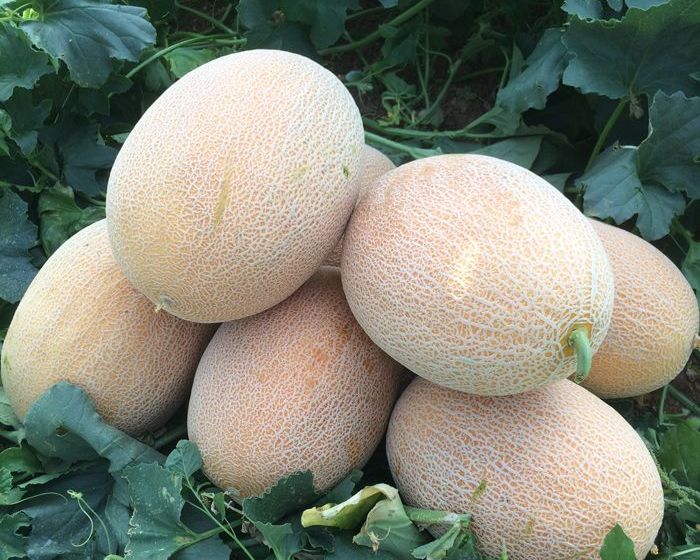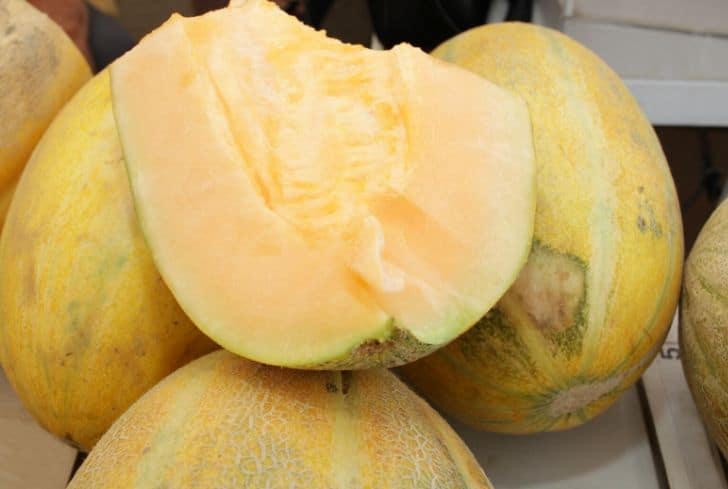Melons are tasty and beautiful fruits that grow on vines sprawling across the ground. Belonging to the Curcurbitaceae family, Melon trees can be held upright with some support. While you cannot conventionally call them attractive, they are still incredibly popular for their sweet fruits.
These plants have been grown for the last 4,000 years and since inception, they’ve served as a vital food source for the Africans and Egyptians.
Now, there are multiple variants of Melons with different tastes and appearances. However, almost all of them are easy to grow and maintain.
This article will discuss the 15 commonly found types of Melons.
15 Different Types of Melons
1. Watermelons
Regardless of where you live, you are probably familiar with Watermelons. Native to the African regions, these fruits have been produced and consumed for several thousand years.
Currently, at least 1,200 regions cultivate watermelons that produce fruits ranging from 6 to 50 pounds. Interestingly, these watermelons have similar features, including their solid outer rind and the relatively soft interior flesh.
As with most other melons, watermelons have a drastically high-water content, up to a whopping 92%, probably why they are referred to as watermelon in the first place.
The high content of water makes it one of the most delicious and widely sought-after snacks during the warmer months. Their substantial size ensures an enduring coolness, persisting even after extraction from the refrigerator.
As a favorite fruit for most people, watermeons are cultivated all across the globe. But it’s China that leads the line as one of the greatest producers of the fruit, boasting an astounding 70% of world’s watermelon produce.
Brazil and Turkey come after China, with United States also featuring among the heavy producers of the fruit. In fact, about 40 states of the nation are known to produce commercial variants of watermelons, but it’s Georgia, California, Texas, and Florida dominating in their production, with the four states accounting for 80% of all the fruit produce in the United States.
Watermelons thrive best in temperate or hot climates, but they can still be grown in moderately cold areas and they’ll thrive just fine.
But that’s not all it takes to succeed in watermelon production — it’s also important to check the quality of the soil. Ideally, you should grow watermelons in well-draining soil as it isn’t tolerant enough to grow and thrive in soggy conditions. You can also grow them on heavy, hairy vines that primarily trail around the ground.
This type of melon produces dense foliage and pale-greenish flowers during the warmer months of July and August. And while the fruit is deemed incredibly tasty by the fans, the plant, per se, isn’t very attractive. In fact, in certain regions is deemed to be a weed.
Watermelons, however, are still widely sought-after by gardeners as they grow quickly and are easy to maintain. These watery fruits require a fairly long time than other melons to achieve maturity, usually 90 days.
2. Ananas Melon
Native to the Middle Eastern region, Ananas is a variety of muskmelons. They have an oval shape and feature a relatively netted rind almost similar to Cantaloupes.
Unlike watermelons, their interior flesh varies from a light shade of off-white to a light shade of orange/occur yellow. They are widely popular for their elongated seed cavities and are incredibly sweet, although in certain instances, they may also have a mild spicy flavor.
3. Camouflage Melon
Alternatively known as the Christmas Melon, Frog Skin Melon, and even Santa Claus Melon, the Camouflage Melon is primarily found in Australia. Given their similarity to the frog skin, Australians also call them Croc-melons once in a while.
However, despite being widely produced in Australia, these melons are native to Spain. The fruit is available in a shade of green and brown, with interiors that resemble the creamy off-white texture of a honeydew. They are both beautiful and extremely tasty.
4. Cantaloupe
Two kinds of melons are widely termed Cantaloupe. These include the European and North American Cantaloupes. Among them, the former was cultivated during the early eighteenth century in the Cantalupo region of Italy, which is where they also get their name.
The European Cantaloupe features a grayish skin with vertical white stripes and is often termed as the True Cantaloupe.
The North American Cantaloupe, on the other hand, comes with a netted smooth skin and is planted in the warmer regions of Mexico and the US.
However, both the European and North American cantaloupe have a sweet, orangish flesh resembling a Papaya. Given their sweet taste, these fruits are often consumed as breakfasts, fruit salads, and desserts.
The vines of Cantaloupe produce bright yellow flowers during the warmer months. They also feature stunning foliage that varies from dark greenish to cream depending on the season when they are cultivated.
5. Casaba Melon
Native to the United States, the Casabas have been popular since the early 1800s. They are viewed as a close cousin of the Honeydews and the Cantaloupes. Usually served in fruit platters and salads, the flavor of these melons resembles that of a cucumber. The best part: you will find them both during summers and winters!
Casabas have a fairly long shelf life, and transform into a yellowish hue upon ripening. They also have fairly smooth skin and feature wrinkled, elongated furrows.
While they are relatively less popular than the more conventional forms of melons, you can grow Casabas at any time throughout the year, similar to what happens in their country of origin.
6. Galia Melon
Native to Israel, the Galia Melon is a hybrid melon between the Honeydew and the Cantaloupe. These melons are usually round with a highly nettled rind and a mildly spicy flavor.
Currently, the Galia melon is cultivated across the globe in warmer climates. It is primarily found in South America, the United States, and Europe.
7. Canary Melon
Belonging to the family of Musk Melons, Canary Melons are bright yellowish melons with a tangy and sour taste. Its flesh has a pale greenish hue with a fairly soft texture when ripened. The canaries are oval and larger when after maturing. The vines of these plants may trail or creep, producing beautiful yellow flowers during Spring.
The plant takes around two and a half months to grow fruits and is widely found in Asian and South American regions. They are widely used in fruit salads and as a common breakfast staple.
8. Bitter Melon
Popularly known as Pare in Indonesian regions, the Bitter melon is known to originate from the Indian subcontinent. Its vines are also widely grown across Asian, African, and Caribbean regions.
As evident from the name, these melons are extremely bitter and are therefore eaten as a vegetable instead of a fruit. The Bitter melon is also rich in antioxidants and is known to boost one’s immunity.
9. Charentais Melon
This is one of the rare melons that is widely popular for its fragrance and not taste. Unlike other melons, the Charentais Melon has a sweet and refreshing fragrance. Having originated in France during the early nineties, these Melons are widely produced in North Africa.
While its production is more or less limited in the United States, you will still find them in some grocery stores in the Southern US states. These fruits are perfectly round with a light greenish hue and darker greenish horizontal stripes across the body. The flesh is also bright orangish in color.
10. Crane Melon
Found in California during the early 1900s, the Crane Melons have beautiful orange flesh and are known for their incredible freshness and sweet taste. As with several other melons featured in this list, Crane Melons are usually a kind of hybrid from Persian, Japanese, and Ambrosian variants of melons.
11. Winter Melons
These melons derive their name from their unbelievably long shelf life. While they are primarily cultivated during the warmer months, the Winter melon is still ideal for consumption during the winter months. In fact, they can still be edible up to 12 months after harvesting!
The spectacular longevity of this melon is credited to the waxy skin, ensuring the inner flesh is fresh and juicy all year round. Note that the skin completely develops only after the fruit is ripe.
As with many other variants of melons, the Winter Melons feature a dark greenish exterior resembling watermelon. Their flesh is pale orange and heavily seeded.
Fruits derived from the vines of winter melon are popular for their large structures and they often weigh up to and more than 40 pounds. Winter Melons are also known to produce beautiful yellow flowers with dense foliage.
12. SkyRocket Melon
Weighing up to a whopping 3 kgs, these melons are round-shaped fruits with a webbed greenish and yellowish tinge. Their flesh is both sweet and refreshing, and their texture is usually chewy. Ideally, it takes around 2 months or more to successfully cultivate a Sky Rocket Melon.
13. Honey Globe Melon
Primarily found in the Southeast Asian regions, these melons are best known for their short harvesting period and high price tag. As you’d probably guess from the name, these melons are extremely sweet and completely round in shape.
With more than 20% of sugar content, the Honey Globes are also one of the tastiest and sweetest melons available. Their rind is thick with white or greenish marks, with the fleshy part being white, soft, and juicy.
The Honey Globe Melon can weigh up to a whopping 10 pounds, and unlike several other variants of melons, you need to cut them from the vine to harvest them. This usually happens due to the super thick stem that keeps the fruit duly attached to the vine.
14. Gac Melons
Alternatively known as the Vietnamese melons, the Gac Melons originate from Vietnam. You will also find them in several other places across the globe, including regions of Australia, China, and Asia. Gacs are oval with a measurement of up to five inches. They feature a spiked red or orangish rind.
The inner fruit of gacs is made from two different parts, both edible. Gacs are primarily used as a vegetable owing to their unique taste. They are not as sweet and often resemble the taste of avocados. In fact, it’s for this reason that these melons are widely used while making soups, stews, and curries.
15. Autumn Sweet
This is yet another unbelievably sweet variant of Melon. Like many other melon variants, Autumn Sweets have a round shape, weighing up to 1.3 kgs. Their skin has a golden yellowish hue, and their flesh is primarily white. Autumn Sweet melons are extremely sweet, and their texture is both tender and watery.
Well, now that you have a detailed insight into what Melons are, what are you waiting for? Take your pick and grow them at home to enjoy ripe, sweet melons all year round!
References:




















